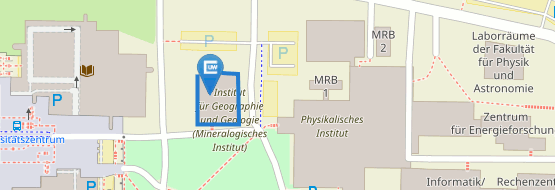X-ray fluorescence laboratory
Regulations for the use of the X-ray fluorescence analysis (XRF) laboratory
According to the decision of the Department of Geodynamics and Geomaterials Research of the University of Würzburg dated 13.12.2021, the use of the XRF laboratory is regulated by the following usage regulations.
Please note: The device is subject to the radiation protection regulations of the department!
1. Laboratory equipment
The core of the laboratory is a PANALYTICAL MINIPAL4 XRF instrument with a low-power X-ray tube, an energy dispersive X-ray spectrometer and a 12-fold sample changer. Analytical capabilities include qualitative and quantitative total rock/total material analysis of major and minor elements starting at atomic number 11 (Na) and selected trace elements. The routine analysis refers primarily to geological sample material, i.e. rocks, ores, soil samples, etc., but also to archaeological and modern materials (e.g. glass, ceramics).
2. Sample preparation
For XRF, the samples are crushed in the coarse preparation laboratory with a jaw crusher, pulverized with a vibrating disk mill, dried in a drying oven, weighed with a flux (lithium tetraborate) and melted on a gas burner column to form a glass tablet. In addition, the loss on ignition is determined on a separate subsample in a muffle furnace. This work is carried out by the users themselves, but may only be done under the guidance of the employee responsible for preparation.
3. Appointment
Appointments for sample preparation and measurements are requested from the supervising persons (by telephone, e-mail, or in person) and entered in a calendar. All appointments are non-binding, as disturbances in the laboratories can occur at any time, resulting in rescheduling. Significant changes to the measurement schedule, which may result from an instrument shutdown with prolonged service calls, are discussed in consultation with the workgroup leaders, taking into account in particular the urgency of a measurement project (e.g., deadline for BSc theses).
4. Costs
The cost of the laboratory is composed of two items:
1. Costs for acquisition and operation
- Power
- Support position
- Repair costs
- Replacement of electrical and mechanical components that are not typical wear items (e.g., power supplies; computers; labware)
2. Costs for carrying out the measurement operation and for ensuring the quality of the analysis
- Costs for special gases (helium flushing of the sample chamber)
- Running costs for consumables (chemicals for sample preparation, spectrometer windows)
- Costs for maintenance and service
- New purchase, or repurchase of certified standards
For the calculation of the proportionate laboratory costs that can be allocated to academic users, only the laboratory costs for carrying out the measurement operation and for ensuring the quality of the analysis were taken into account. This results in the following flat rates for use for different user groups:
• 18 € / analysed sample – for all academic work carried out by members of the department (under the responsibility of the respective working group leaders) as well as for those guests who cooperate directly with the working group leaders in joint projects.
• 25 € / analysed sample – for university members who are not part of the Department of Geodynamics and Geomaterials Research and for such guests who do not cooperate with the working group leaders within the framework of projects.
• 120 € / analysed sample – for third parties (companies, non-institutes) within the framework of commercial contract analysis. These costs include sample preparation, measuring instrument time, intensive support of the project by the operator, evaluation of the data, writing of a report.
Würzburg, 13.12.2021
Dr. Stefan Höhn, Tel. 0931-31-85422 oder stefan.hoehn@uni-wuerzburg.de


